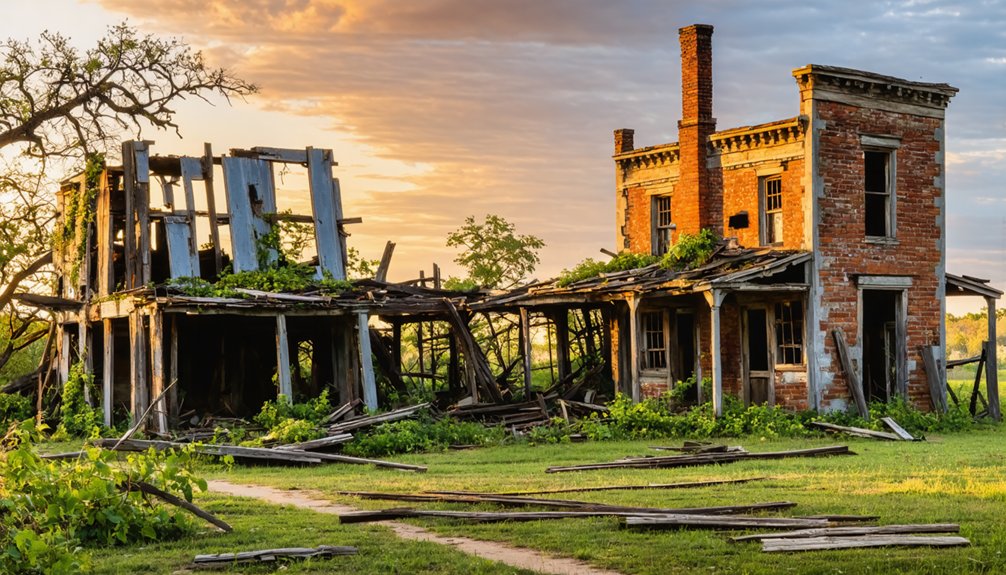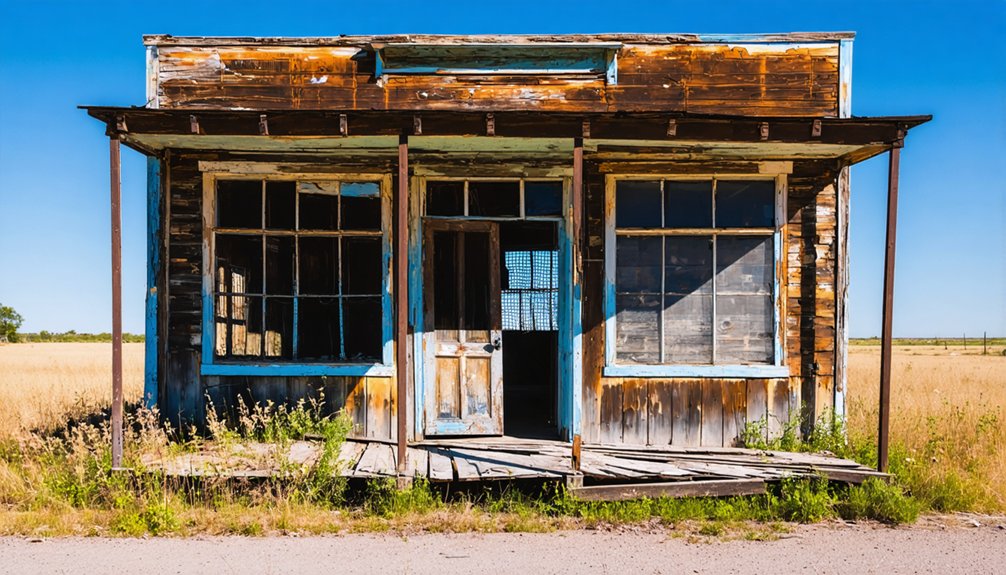You’ll find Carpenter, Texas tucked away in Wilson County, where it began as a promising railroad town in 1893. Named after local landowners Henry and James Carpenter, this agricultural hub thrived with cotton gins, general stores, and an essential post office serving farming families. After the railroad’s decline, severe droughts, and the post office’s closure in 1914, Carpenter gradually faded into a ghost town. Its abandoned structures and crumbling foundations tell an intriguing tale of Texas’s boom-and-bust legacy.
Key Takeaways
- Carpenter, Texas, established in 1893 by the San Antonio and Mexican Gulf Railroad, is now an abandoned ghost town in Wilson County.
- The town’s decline began with reduced railway services, severe droughts, and the closure of its post office in 1914.
- Most original structures are deteriorating, with crumbling foundations and weather-worn wooden buildings visible through overgrown vegetation.
- The site attracts history enthusiasts and ghost town explorers but has limited accessibility due to private property restrictions.
- Agricultural activities, including cotton production and farming, were central to the town’s economy before its eventual abandonment.
Origins and Early Settlement
While numerous Texas settlements emerged along railroad lines in the late 19th century, Carpenter’s story began in 1893 when the San Antonio and Mexican Gulf Railroad established a stop between La Vernia and St. Hedwig.
The founding significance stems from local landowners Henry and James Carpenter, whose influence on the area’s development earned them the honor of having the settlement bear their name.
You’ll find that early residents were drawn to the fertile land’s agricultural potential, establishing farms and businesses to serve the growing community.
The strategic location in western Wilson County, now part of the San Antonio Metropolitan Statistical Area, proved ideal for both farming and commerce.
Much like the establishment of Carpenter around 1860, the railroad’s arrival formalized what had been an informal settlement, transforming it into a crucial hub where farming families and traders could connect to broader markets.
Like many towns of that era, the settlement followed a similar trajectory to Thurber, which relied on a once-a-month paycheck system to maintain control over its workforce.
Railroad’s Role in Town Development
Although the Houston and Texas Central Railway initially envisioned Red River City as its northern terminus, legal disputes with the Missouri-Kansas-Texas Railroad in 1872 reshaped the region’s rail development.
Legal battles between rival railroads in 1872 altered the planned northern endpoint of the Houston and Texas Central Railway route.
When Denison emerged as the primary rail junction, it transformed transportation patterns across northeastern Texas.
You’ll find that Carpenter’s railroad impact came later, with the Kansas, Oklahoma and Gulf Railway‘s construction of a bridge at Carpenter’s Bluff in the early 20th century.
This transportation evolution marked a turning point for the community, connecting it to Sherman and broader economic networks.
The Denison & Pacific Railroad completed its westward expansion to Gainesville in 1879, further strengthening regional connectivity.
The bridge’s later modification to accommodate automobiles, and its eventual conversion to a two-lane road in 1966, reflects the shifting transit needs of the region.
Despite Carpenter’s eventual decline, the rail infrastructure helped sustain the town through its peak years.
The connection to Sherman proved vital for moving cotton and agricultural products more efficiently through the region’s expanding rail network.
Economic Growth and Local Industries
After the cotton gin‘s relocation to Carpenter in 1897 by Mr. Carmicle, the town’s agricultural evolution took root. You’d find a bustling community where local entrepreneurship flourished through family-run businesses like the Winklers’, Kosubs’, and Plochs’ general stores.
These establishments weren’t just retail outlets – they formed the backbone of Carpenter’s rural economy, offering credit systems that aligned with farming cycles. William B. Pierdolla, the town’s first postmaster, helped establish vital communication links that supported these growing businesses. Just as 500 years of history shaped Texas, these local businesses became integral to Carpenter’s identity.
- Cotton bales stacked high at the gin during harvest season
- Sheet metal workers crafting essential water cisterns at Ploch’s shop
- Farm families gathering at local saloons after market days
- Railroad cars being loaded with cotton bound for distant markets
The town’s strategic position as a flag station enhanced its role as an agricultural service center, though it never developed significant industrial diversity beyond farming-related enterprises.
Daily Life and Community Services
The fabric of daily life in 1914 Carpenter centered around a handful of essential establishments that kept the farming community running.
You’d find the blacksmith repairing crucial farming equipment, while two general stores supplied necessities and served as hubs for community gatherings. The local saloon provided a space for socializing after long days in the fields.
Local craftsmen and merchants kept Carpenter’s heart beating, from the blacksmith’s vital repairs to lively gatherings at the general stores.
Your daily schedule would’ve followed strict agrarian routines, rising with the sun to tend to cotton fields and livestock. Much like the struggles of abandoned mining towns, residents had to be self-sufficient and resourceful to survive the challenges of frontier life. Like other small Texas communities, it shared the fate of nearby towns such as Sweet Home, which was established by former slaves.
You’d likely wear practical clothing, similar to the denim workwear common in other Texas farming towns. Without a local doctor, you’d rely on home remedies or travel to nearby towns for medical care.
While the post office had closed by 1914, you’d still find plenty of news and conversation at the general stores or saloon.
Population Changes Through the Years
While Carpenter’s founding in 1890 sparked initial optimism, the town’s population never exceeded 50 inhabitants during its brief existence.
The establishment of a post office and arrival of the Little Book Cliff Railway brought temporary demographic shifts, but you’d have found only modest population stability during the early 1890s. Despite the presence of skilled conservation carpenters who maintained historic structures, the town struggled to grow. Other mining communities like Thurber recruited foreign workers to grow their workforce.
- Mining families occupied simple company housing
- A handful of workers crowded into boarding houses
- Post office workers served the tiny community
- Railway workers passed through regularly
Unlike thriving mining towns such as Thurber that grew to thousands, Carpenter couldn’t sustain growth beyond its initial settlers.
Key Events Leading to Decline
Several devastating blows struck Carpenter in rapid succession during the late 1890s, triggering an irreversible spiral of decline.
You’d have seen the mining operations scale back dramatically, exposing the town’s economic vulnerability as it struggled to diversify beyond resource-based industries. The railway’s reduction dealt another significant blow, leading to transportation isolation that cut off essential commercial lifelines.
Severe droughts ravaged local agriculture while environmental damage from mining made land increasingly unusable.
The town’s social fabric began unraveling as younger residents fled for better opportunities elsewhere. When the post office closed in the early 1900s, it marked a turning point in Carpenter’s fate.
The subsequent loss of company-sponsored infrastructure and services left remaining residents with diminishing resources and limited options for recovery.
Present-Day Ghost Town Status

Today, Carpenter stands as a haunting reminder to Texas’s boom-and-bust legacy, with its remaining structures largely abandoned and deteriorating amid the harsh elements.
You’ll find the current infrastructure has completely ceased to function, with no active utilities or public services remaining. While the town’s population has dwindled to virtually zero, its historical significance draws occasional visitors interested in Texas ghost towns.
- Crumbling foundations peek through overgrown grass
- Weather-worn wooden structures lean precariously in the wind
- Empty streets stretch between vacant lots where homes once stood
- Scattered ruins tell silent stories of past prosperity
Despite limited accessibility due to private property restrictions, Carpenter’s tourism potential remains untapped.
The site falls under preservation guidelines that protect its historical remnants while offering a glimpse into Texas’s rural past.
Frequently Asked Questions
Are There Any Remaining Structures From Carpenter’s Original Buildings Still Standing Today?
Like scattered breadcrumbs of history, you’ll find a few stone ruins and structural fragments behind fencing today, but most of Carpenter’s original buildings haven’t survived time’s relentless march.
What Natural Disasters or Extreme Weather Events Affected Carpenter During Its Existence?
You won’t find specific records of natural disasters in Carpenter’s history, though the area likely experienced regional drought effects and potential flood impacts common to central Texas during that era.
Were There Any Schools Established in Carpenter During Its Populated Years?
You’d think a ghost town would leave behind ghostly schoolhouses, but there’s no documented evidence of any formal education facilities in Carpenter during its brief existence. Local education history remains mysteriously blank.
Did Any Notable Crimes or Significant Law Enforcement Incidents Occur in Carpenter?
You won’t find any documented notable crimes or law enforcement incidents in historical records from this location. Unlike other Texas ghost towns, there aren’t any unsolved mysteries tied to this settlement.
What Native American Tribes Originally Inhabited the Area Before Carpenter Was Established?
You’ll find the Iones, Kickapoos, and Comanches were dominant in Carpenter’s area, while the Caddo culture influenced regions eastward. These tribes maintained complex tribal relations through trading and territorial disputes.
References
- https://en.wikipedia.org/wiki/Carpenter
- https://nowmagazines.com/2024/01/30/tales-of-texas-history-of-a-ghost-town/
- https://en.wikipedia.org/wiki/List_of_ghost_towns_in_Texas
- https://www.tshaonline.org/handbook/entries/carpenter-tx
- https://losttexasroads.com/history/places/carpenter-texas/
- https://www.texasescapes.com/CentralTexasTownsNorth/Carpenters-Bluff-Texas.htm
- https://www.youtube.com/watch?v=phjUE19A8HM
- https://www.texasalmanac.com/places/carpenters-bluff
- https://authentictexas.com/then-came-the-railroad/
- http://txrrhistory.com/towers/093/093.htm



